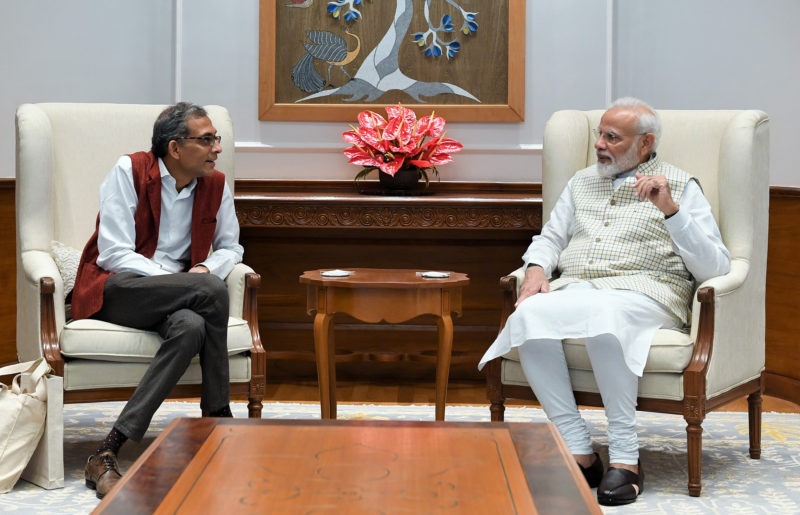Way Out of India’s Economic Downturn: Economy Turning to be Modi-India’s Achilles Heel
Economics Nobel winner Abhijit Banerjee meeting Prime Minister Narendra Modi in New Delhi, Oct. 22. (PIB)
As one of the most awaited festive seasons, Diwali, draws near and the Bharatiya Janta Party leading the NDA government at the centre remains deeply engrossed with painting all state-assemblies saffron in the midst of boldly delivering on longstanding socio-political demands of India, the grip of an economic downturn is getting tighter by the quarter and refusing to let up even in its 20th month of existence.
Growth indices revealing a decline to a six-year low of 5 percent in the June-September quarter of 2019, lowest since 2012-2013, have alarmed economists and analysts alike, who predict further downward trends in coming fiscal.
The general fear is that if this slowdown, previously exacerbated by growth headwinds of demonetization and confusion over the Goods and Services Tax implementation, and then compounded by slump of global trade, overseas funding crunch, muted consumption financing and now by the failure of non-banking financial corporations, is not reined in, it will undeniably aggravate into a scenario, far worse than the 2008 global recession, as inevitable fall outs of the US-China trade wars and Brexit delay get unleashed.
The signs of a dismal GDP growth are visible in massive job loss, shortage in adequate employment opportunities, lower disposable incomes of households that further reduced demand, shrinking investment rates, plummeting stock markets, with the automobile and construction sectors, drivers of economic growth, bearing the burnt, all emanating from factors easily traceable to multiple causes, from corporate and regulatory environmental uncertainties, to stresses in the non-banking financial sector and rural sector in which case government efforts to contain urban inflation was to erroneously lower minimum support prices depressing agricultural spending to a bare minimal.
If any wealth, its concentration in the hands of a few individuals and fewer individual states continues to persist, vivid in differentials in revenue collection, confounding one on how attainable the Prime Minister’s grand goal of a prosperous future, scaling India to a $5 trillion dollar economic powerhouse by 2025, is.
The recent data on tax collection, compiled by the Central Board of Direct Taxes, shows Maharashtra, Delhi and Karnataka topping all states with contributions of 61 per cent to the country’s total revenue from direct taxes, and along with Tamil Nadu and Gujarat their collective share was at 72 per cent.
The 2018-2019 figures for collections of direct tax that mainly includes income taxes paid by individuals and corporate taxes paid by firms also recorded a huge jump of 54.76 per cent, indicating the increasing strength of formal sector, particularly services sector, or in other words better employment opportunities and greater ease-of-doing-business.
In last six years as well, revenue from personal income tax made for 40.24 per cent of the total revenue collected from direct taxes in Delhi, Maharashtra and Karnataka that form the three largest hubs of corporate regions, employing a large section of India’s salaried class coming from migrants of Uttar Pradesh, Bihar and West Bengal.
As all supply side measures and tax cuts are accompanied with time lags and uncertainties the short run to alleviate stagnation cannot be the sole reliable ways out.
Likening the crisis to a Keynesian downswing Nobel Laureate Abhijit Banerjee’s recipe for way out is to put money in the hands of the poor, raise minimum support prices of crops which will push up demand, hike wages besides step up in public investment and government expenditure to revive growth, and even privatize ailing public financial institutions, before it is too late.
But not all are skeptical as the Reserve Bank of India has made for a case of an economic expansion that may move beyond 6.1 per cent in next quarter, an optimist thought supported by forecasts by only a few multilateral agencies such as World Bank and International Monetary Fund, the latter predicting Indian economic growth expected to rebound, even as it slashed its estimate to 6 per cent from an earlier 7.3 per cent, by 2020-2021, on account of government led monetary policy stimulus and corporate income tax cuts.
Critics, however, rue on the use of GDP as the perfect parameter to calculate economic prowess as developed countries such as the USA and developed countries in Europe register just about 1-2 per cent GDP and which is considered fine in their case as compared to developing nations, China and India, that have been regularly clocking in 5-6 per cent of GDP growth rate and still igniting concerns of recession or slowdown.
As the economy has been messed to the lees and may be termed to be in a “tailspin”, the government has a very hard task of fixing up all ends, but rather it is perceived as rebuffing all opposing views or remaining in denial as until recently even when it was apparent to the layman of economics, or passing on the blame to previous UPA era when irrational exuberance in financial institutions ruled the roost, and presenting a rosy picture of India’s economic health to attract investors to India’s growth story.
A sensible corrective for the Modi government would be, therefore, to appreciate matching intention with implementation, of cohesively framed comprehensive structural reforms with immediate impact-policies and decentralization of these without the overhanging worries of accompanying malfeasance, as the main worry of the incumbent must be to prevent disgruntle amongst ordinary voters who would be left with no choice but to descend on the streets and vote with its feat.


